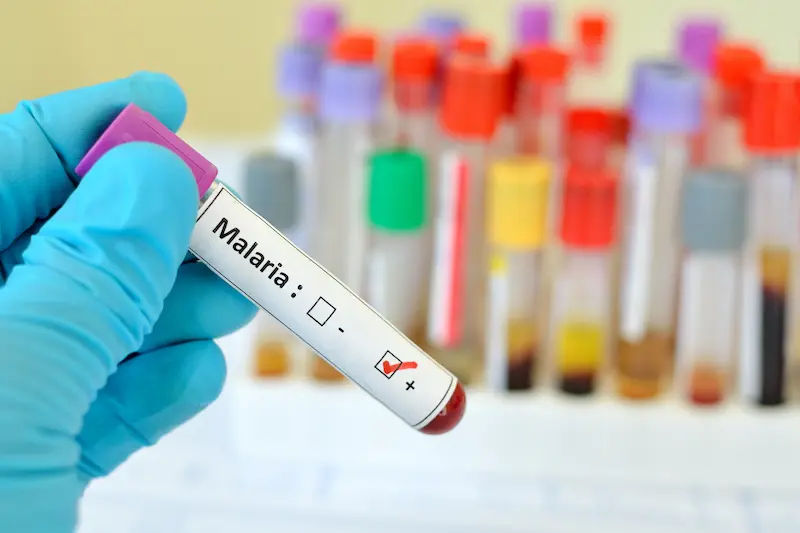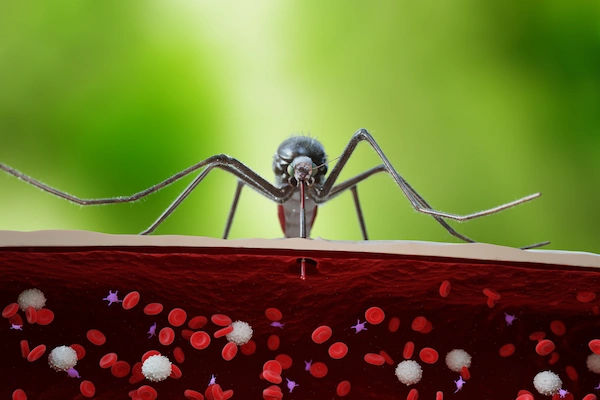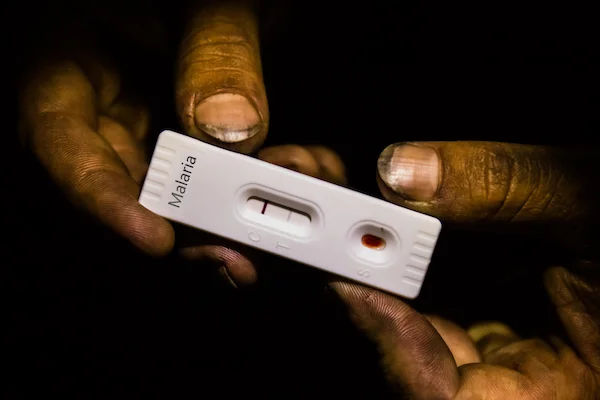Guide to Malaria Can Make You Vulnerable
Don't let malaria catch you off guard. This comprehensive guide details how the disease compromises your immune system and leaves you vulnerable, plus crucial steps for prevention and treatment.

Written by Dr. J T Hema Pratima
Reviewed by Dr. Dhankecha Mayank Dineshbhai MBBS
Last updated on 29th Oct, 2025
.webp?tr=q-80,f-webp,w-350,dpr-2,c-at_max 700w)
Introduction
Malaria is more than “just” a fever—it can make you vulnerable in ways that ripple through your health, family, and community. Caused by Plasmodium parasites and spread by Anopheles mosquitoes, malaria remains a leading cause of illness and death in many regions, particularly for young children and pregnant people. If you live in or travel to malaria-prone areas, understanding how malaria makes you vulnerable—and how to protect yourself—is essential. In this guide, we translate authoritative guidance into practical steps you can use today. You’ll learn what malaria is, who is most vulnerable, the early symptoms to watch for, how diagnosis and treatment work, and how prevention tools—from bed nets and vaccines to prophylactic medicines—dramatically cut risk. We also share how climate, housing, and health access influence vulnerability, plus specific checklists and myths to avoid. Throughout, you’ll find real-world examples and research-based insights, with clear advice on when to seek medical help. Whether you’re a parent, caregiver, traveler, or simply curious, this guide will help you make informed, confident decisions about malaria and stay ahead of the risks.
Understanding Malaria and Why It Can Make You Vulnerable?
Malaria is caused by Plasmodium parasites (most severely by P. falciparum; P. vivax can relapse) spread through the bites of infected female Anopheles mosquitoes. After a bite, parasites first multiply in the liver, then in red blood cells, causing cyclical fevers, chills, and other symptoms. What makes malaria uniquely risky is not just the acute illness but how it increases vulnerability during and after infection.
• Short-term vulnerability: Fever, dehydration, anemia (from red blood cell destruction), and low blood sugar can rapidly worsen, especially in young children and pregnant people. Severe malaria can lead to coma, breathing problems, kidney and liver failure, and death without prompt treatment.
• Longer-term vulnerability: Even after recovery, anemia and fatigue may persist for weeks, affecting work, school, and caregiving. In pregnancy, malaria is linked to maternal anemia, miscarriage, stillbirth, and low-birth-weight babies [6]. Repeated malaria episodes in early childhood can contribute to developmental and cognitive setbacks.
• Community-level vulnerability: Malaria can push families into financial hardship due to lost wages, school absence, and medical costs, creating a cycle where poverty and poor housing increase exposure (e.g., lack of window screens or bed nets), which then sustains transmission.
Two lesser-known insights:
1) Immune shifts during malaria may make children temporarily more prone to certain bacterial infections, especially when severe anemia is present. This helps explain why prompt diagnosis and full treatment matter beyond clearing fever.
2) With P. vivax and P. ovale, “hidden” liver-stage parasites can cause relapses weeks or months later if not treated with a radical cure medicine—an important reason to discuss testing for G6PD deficiency with your clinician before primaquine/tafenoquine.
Related terms to notice: malaria incubation period, post-malaria fatigue and anemia.
Who Is Most Vulnerable to Malaria—and Why?
Anyone can get malaria, but certain groups face higher risks of severe disease and poor outcomes:
• Children under five: Their immune systems are still developing. In high-burden countries, most malaria deaths occur in this age group. Even when children survive, severe anemia or cerebral malaria can have lasting effects on growth and learning.
• Pregnant people: Pregnancy lowers immunity, and the placenta can harbor parasites. Malaria in pregnancy raises the risk of maternal anemia and low-birth-weight infants, which can lead to newborn complications. WHO recommends intermittent preventive treatment in pregnancy (IPTp) with sulfadoxine–pyrimethamine (where it remains effective) during antenatal visits.
• Travelers, migrants, and people who recently left endemic areas: Without partial immunity, travelers can become severely ill quickly. Migrant workers and people moving for seasonal work may also sleep outdoors or lack bed net access, increasing exposure.
• People with HIV, malnutrition, or chronic conditions: HIV coinfection, undernutrition, and illnesses that strain the heart, lungs, or kidneys intensify risks. For example, severe malaria can precipitate acute respiratory distress or kidney injury.
• Communities facing poverty or conflict: Limited access to prevention (ITNs/IRS), overcrowding, poor drainage, and disrupted health services create “vulnerability hotspots,” especially after floods or displacement.
• Real-life example: Seasonal malaria chemoprevention (SMC) in the Sahel, where children 3–59 months receive monthly preventive medicines during peak season, has cut cases and deaths substantially when combined with ITNs. This shows how tailored strategies reduce vulnerability for the youngest.
Unique insight:
“Forest goers” and mining or agricultural workers who sleep near breeding sites are often missed by standard indoor spraying campaigns. Portable nets, repellents, and community outreach are essential for these groups.
Symptoms and Early Warning Signs: When to Seek Care?
Common symptoms usually appear 7–30 days after an infective bite (shorter for falciparum, longer for vivax). The classic pattern is fever with chills and sweats, but presentations vary. Watch for:
• Uncomplicated malaria. Fever, chills, sweats, headache, body aches, fatigue, nausea/vomiting. In children, poor feeding or irritability may be the only clues.
• Severe malaria—medical emergency: Any of the following warrants urgent care: confusion, extreme weakness (cannot sit/stand), repeated vomiting, severe anemia (pale lips, fast heartbeat), breathing difficulties, seizures, dark or scanty urine, jaundice, or bleeding/bruising.
Malaria vs dengue vs typhoid:
• Dengue: Often higher fever with severe body and eye pain, rash, and a risk of bleeding; typically no malaria-style cyclic chills. Platelet counts often drop.
• Typhoid: More gradual onset with prolonged fever, abdominal pain, constipation or diarrhea.
• In mixed-transmission regions, co-infections are possible—don’t assume it’s “just dengue” or “just malaria.” A rapid test or blood smear can clarify, and early testing is key.
When to see a doctor?
• If you live in or have recently traveled to a malaria area and have fever, get tested the same day.
• If symptoms persist beyond 48–72 hours, worsen, or recur, seek medical care promptly. If symptoms persist beyond two weeks, consult a doctor online with Apollo24|7 for further evaluation. Urgent symptoms (confusion, severe weakness, breathing trouble, seizures) require emergency care immediately.
Diagnosis: Tests You May Need and What Results Mean?
Confirming malaria requires a lab test. The main options are:
• Rapid diagnostic tests (RDTs): A finger-prick blood test that detects parasite proteins (e.g., HRP2 for P. falciparum; pLDH for other species). Results in 15–20 minutes. Useful for quick decisions, especially where microscopy isn’t available.
• Microscopy (thick and thin blood smears): The “gold standard” in many settings. A trained technician can see parasites, estimate parasite density, and identify species (important for P. vivax/P. ovale relapse risk).
• PCR: Highly sensitive; used in reference labs and outbreak investigations. Not typically needed for routine care.
Accuracy and timing tips:
• If the first test is negative but malaria remains strongly suspected, retest in 12–24 hours. Early infections may be below detection thresholds.
• Some areas report HRP2 gene deletions in P. falciparum that can cause false-negative HRP2-based RDTs; combining RDTs with microscopy mitigates this risk.
• Always share travel history (countries, dates, rural vs urban stays), bed net use, and any prophylaxis taken—this narrows likely species and guides care.
Convenience and home testing:
• Many labs offer same-day malaria testing. Apollo24|7 offers a convenient home collection for tests like a malaria rapid antigen test, complete blood count (to assess anemia/platelets), and blood smears, helping you get answers fast without a clinic wait.
Unique insight: If P. vivax or P. ovale is suspected, ask your clinician about G6PD deficiency testing before taking primaquine/tafenoquine for relapse prevention—these drugs are highly effective but must be used safely.
Consult a Top General Physician
Treatment and Recovery: What to Expect?
Treatment depends on species, severity, pregnancy status, and local resistance patterns. Do not self-medicate—see a clinician promptly.
• Uncomplicated P. falciparum: Artemisinin-based combination therapy (ACT) is first-line in most regions (e.g., artemether–lumefantrine). It quickly reduces parasite load and cuts transmission.
• Uncomplicated P. vivax/P. ovale: An ACT (or chloroquine in areas where still effective) to clear blood-stage parasites, plus a “radical cure” (primaquine or tafenoquine) to eliminate liver stages and prevent relapse. G6PD testing is needed before primaquine/tafenoquine.
• Severe malaria. Intravenous artesunate in a hospital is recommended; supportive care may include fluids, transfusions for severe anemia, oxygen, and close monitoring
Pregnancy considerations:
• Malaria in pregnancy requires urgent evaluation due to risks for mother and baby. Your clinician will choose safe regimens based on trimester and severity.
Recovery and post-malaria care:
• Hydration, rest, and finishing all doses are crucial. Expect improvement of fever within 24–48 hours for uncomplicated malaria. Fatigue and mild anemia may persist—nutritious meals (iron-rich foods), hydration, and gradual return to activity help.
• Watch for recurrence of fever in the weeks after P. vivax/P. ovale infections; discuss radical cure completion with your doctor.
• If your condition does not improve after treatment or if fevers return, book a physical visit to a doctor with Apollo24|7. For follow-up labs (CBC, liver/kidney function when indicated), home collection can simplify care.
Unique insight: Don’t donate blood for at least several months after malaria, and disclose your history—guidelines vary by country to protect recipients.
Prevention That Works—Especially for the Most Vulnerable
A layered approach offers the strongest protection:
At home and in communities:
• Sleep under insecticide-treated nets (ITNs); replace or retreat nets as recommended. ITNs reduce child mortality and infections significantly.
• Use indoor residual spraying (IRS) where available; it coats walls with long-lasting insecticides, killing mosquitoes that rest indoors.
• Block entry points: Install screens on windows/doors, repair holes, and use fans (mosquitoes are weak fliers).
• Remove mosquito breeding sites: Clear standing water from containers, gutters, and yards. Cover water storage.
• Choose protective clothing and repellents (DEET, picaridin) in high-risk hours (dusk to dawn).
Targeted chemoprevention:
• Seasonal malaria chemoprevention (SMC): In parts of the Sahel, children 3–59 months receive monthly preventive medicines during high-transmission months, cutting cases and severe disease.
• Intermittent preventive treatment in pregnancy (IPTp): Pregnant women receive sulfadoxine–pyrimethamine doses at scheduled antenatal visits where effective.
Travelers and visiting friends and relatives (VFR):
• Seek pre-travel advice 4–6 weeks before departure. Depending on destination, consider atovaquone–proguanil, doxycycline, or mefloquine for prophylaxis. Take every pill as prescribed—including after return—to prevent “late” malaria.
• Pack a personal protection kit: ITN, repellent, permethrin-treated clothing, fever thermometer. If fever occurs during or after travel to a malaria area, get tested promptly.
Unique insight: Outdoor workers, forest-goers, and campers benefit from portable, insecticide-treated hammock nets and spatial repellents; community programs increasingly target these “missed” populations.
Vaccines and New Tools on the Horizon
Vaccines are adding a powerful new layer of protection for children in high-burden areas:
• RTS, S/AS01: Recommended by WHO in 2021 for areas of moderate to high P. falciparum transmission; has shown meaningful reductions in severe malaria and hospitalizations when delivered through routine immunization programs.
• R21/Matrix-M: Recommended by WHO in 2023; shows similar efficacy in clinical studies and is expected to expand vaccine supply, allowing more countries to roll out protection for at-risk children.
How vaccines fit in?
• Vaccines complement—not replace—ITNs, IRS, SMC/IPTp, and prompt treatment. Programs that combine vaccines with high ITN coverage show the greatest impact.
• Staying ahead of resistance:
• Insecticide resistance in mosquitoes and artemisinin partial resistance in parasites have emerged in some regions. This is why integrated vector management (using multiple, rotating tools) and robust case management remain essential.
Unique insight: Next-generation dual-active ITNs (combining pyrethroids with another active ingredient) are being deployed in areas with high insecticide resistance to restore net effectiveness.
Climate, Housing, and Social Factors That Increase Vulnerability
Climate and environment:
• Warmer temperatures and changing rainfall can expand or shift mosquito habitats, raising malaria risk in some highland or fringe areas while altering timing elsewhere. Floods can drive spikes by creating temporary breeding sites and overloading health services.
• Housing and infrastructure:
• Houses without screens, leaky roofs, or open eaves invite mosquitoes in.
Overcrowding and poor drainage add risk. Simple upgrades—screening, sealing eaves, installing gutters—can reduce indoor mosquito density substantially.
Social and economic context:
• Poverty limits access to nets, repellents, and timely care. Conflict and displacement displace people to high-exposure settings and disrupt prevention campaigns. Targeted distribution (e.g., ITNs at refugee reception), mobile clinics, and cash or voucher programs can reduce these vulnerabilities.
Unique insight: Community-led mapping of “bite hotspots” (outdoor gathering places, nighttime markets, worker camps) helps local health teams tailor interventions such as focal IRS or net distribution where they are most needed, improving impact without massive cost.
Myths vs Facts
• Myth: “If I don’t see mosquitoes, I can’t get malaria.” Fact: Night-biting Anopheles are easy to miss; one infected bite can cause malaria.
• Myth: “Dengue and malaria are basically the same.” Fact: They’re caused by different organisms, need different tests and treatments, and can co-occur.
• Myth: “Once I’ve had malaria, I’m immune.” Fact: Partial immunity can develop with repeated exposure, but it’s incomplete and wanes. Travelers remain at risk.
• Myth: “Herbal remedies can cure malaria.” Fact: Only proven antimalarials cure malaria. Delays can lead to severe disease.
• Myth: “Vaccines mean I can skip nets or meds.” Fact: Vaccines add protection but do not replace ITNs, prophylaxis, or prompt treatment.
Your Action Plan and Checklist
For families in malaria areas:
• Sleep under an intact insecticide-treated bed net every night; repair or replace damaged nets.
• Reduce mosquito entry: screens on windows/doors, fix eaves, use fans at night.
• Remove standing water weekly; cover stored water.
• Keep a thermometer and know fever warning signs; seek testing the same day fever appears.
• Pregnant? Ask your provider about IPTp. Parents? Ensure children are up-to-date on malaria prevention services and vaccines where available.
For travelers:
• Get pre-travel advice 4–6 weeks before departure; follow malaria prophylaxis strictly.
• Pack an ITN, repellent (DEET or picaridin), permethrin-treated clothing, and a fever plan.
• After returning, any fever, tell your clinician where you traveled and get tested.
When to get help?
• Persistent or worsening fever, severe symptoms, or uncertainty about diagnosis—seek care now. If symptoms persist beyond two weeks, consult a doctor online with Apollo24|7 or book an in-person visit.
Conclusion
Malaria remains a serious threat, but it’s a threat you can manage with the right knowledge and tools. Understanding how malaria makes you vulnerable—from the immediate risks of severe disease to the longer-term impacts on pregnancy, child development, and family finances—helps you act early and effectively. If you live in or travel to malaria-affected areas, lean on a layered approach: sleep under insecticide-treated nets, improve home protection, clear standing water, and ensure timely testing and treatment at the first sign of fever. If you’re pregnant or caring for a young child, ask about preventive medications and vaccines where available. Travelers should get pre-travel advice and adhere closely to prophylaxis. Ultimately, the biggest gains come from combining personal steps with community-wide strategies—and from acting quickly when symptoms appear. If your condition does not improve after trying these methods, book a physical visit to a doctor with Apollo24|7, and consider convenient home collection for malaria tests and a complete blood count to track recovery. With awareness, preparation, and prompt care, you can reduce your risk dramatically and protect those most vulnerable.
Consult a Top General Physician
Consult a Top General Physician

Dr Bhargav Vuppumalla
General Physician/ Internal Medicine Specialist
5 Years • MBBS MD GENERAL MEDICINE
Bengaluru
Apollo Medical Center, Marathahalli, Bengaluru
Dr P Sai Avinash
General Physician/ Internal Medicine Specialist
7 Years • MBBS
Bengaluru
Apollo Medical Center, Marathahalli, Bengaluru

Dr. Tapabrata Ray
General Physician/ Internal Medicine Specialist
4 Years • MBBS,DGM,CPMeC,ACMDC
Kolkata
MCR SUPER SPECIALITY POLY CLINIC & PATHOLOGY, Kolkata
Dr. Paras Gangwal
General Physician/ Internal Medicine Specialist
28 Years • MBBS,MD General Medicine
Delhi
Dr Paras Gangwal Clinic, Delhi

Dr. Gopal Hajare
General Physician/ Internal Medicine Specialist
8 Years • MBBS, DNB GENERAL MEDICINE,MNAMS ( MEDICINE ) FACEE
Pune
Apollo Clinic, Kharadi, Pune
Consult a Top General Physician

Dr Bhargav Vuppumalla
General Physician/ Internal Medicine Specialist
5 Years • MBBS MD GENERAL MEDICINE
Bengaluru
Apollo Medical Center, Marathahalli, Bengaluru
Dr P Sai Avinash
General Physician/ Internal Medicine Specialist
7 Years • MBBS
Bengaluru
Apollo Medical Center, Marathahalli, Bengaluru

Dr. Tapabrata Ray
General Physician/ Internal Medicine Specialist
4 Years • MBBS,DGM,CPMeC,ACMDC
Kolkata
MCR SUPER SPECIALITY POLY CLINIC & PATHOLOGY, Kolkata
Dr. Paras Gangwal
General Physician/ Internal Medicine Specialist
28 Years • MBBS,MD General Medicine
Delhi
Dr Paras Gangwal Clinic, Delhi

Dr. Gopal Hajare
General Physician/ Internal Medicine Specialist
8 Years • MBBS, DNB GENERAL MEDICINE,MNAMS ( MEDICINE ) FACEE
Pune
Apollo Clinic, Kharadi, Pune
More articles from Malaria
Frequently Asked Questions
Q1: What are the first signs of malaria in adults?
Fever, chills, sweats, headache, and fatigue are common early signs of malaria in adults. If you live in or recently traveled to a risk area, get a rapid malaria test the same day you develop a fever.
Q2: Who is most vulnerable to malaria and why?
Children under five, pregnant people, travelers without immunity, and those with HIV or malnutrition are most vulnerable due to weaker or limited immunity and a higher risk of severe complications.
Q3: How accurate are rapid malaria tests, and when should I repeat them?
RDTs are fast and useful but can miss very early infections. If your first test is negative and suspicion remains high, repeat testing within 12–24 hours or ask for a blood smear.
Q4: What is the malaria vaccine, and who should get it?
WHO recommends RTS, S, and R21 for children in areas of moderate to high P. falciparum transmission. These vaccines reduce severe malaria and hospitalizations and complement bed nets and other preventive measures.
Q5: What’s the best malaria prevention for travelers to India or Africa?
Combine repellents, ITNs, and prophylaxis (e.g., atovaquone–proguanil, doxycycline, or mefloquine) tailored to your itinerary. Seek pre-travel advice 4–6 weeks before departure. If fever occurs during or after travel, get tested promptly.




